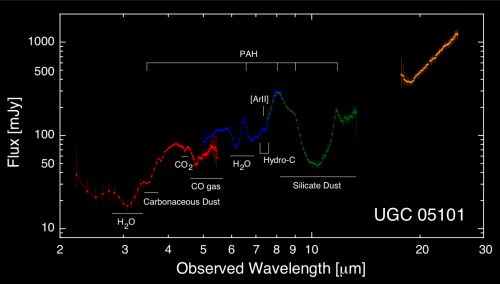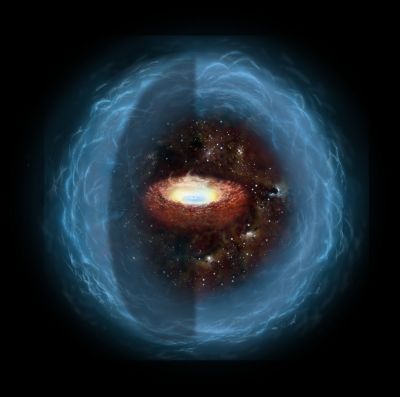AKARI Results
Molecular gas surrounding an active galactic nucleus with a giant black hole at its centre as seen by AKARI infrared observations
- Detection of the molecular gas surrounding the active galactic nucleus in the ultra luminous infrared galaxy UGC05101 -
AKARI has discovered evidence for molecular gas of different temperatures surrounding the active galactic nucleus containing an enormous black hole at its centre. This data will provide vital clues in understanding the structure of galaxies harbouring active galactic nuclei and black holes.
UGC05101 in the constellation Ursa Major is around 550 million light years away from the Earth. The very central part of this galaxy is so bright at infrared wavelengths, that the object is termed an "Ultra Luminous Infrared Galaxy". The total energy emitted from this galaxy at infrared wavelengths alone is about one trillion times more than the total energy of our Sun. However, the central region of this galaxy is covered by a thick interstellar medium, and to this day has never been observed, thus the mechanisms at work in the core region remain a mystery.
Thanks to its high sensitivity in the infrared, AKARI has taken up the quest to unravel the mystery of the central core of HGC05101. Infrared light is in fact, transparent to the intervening interstellar medium, and observations at these wavelengths are expected to answer our questions about the central core. Figure 1 shows the spectrum of UGC05101 from 2 to 13 micrometres observed with the Near- and Mid-Infrared Camera (IRC) onboard AKARI. The spectrum shows many absorption and emission features from dust, molecules, atoms, and ions. Identification of the spectral features is also indicated in the figure. The absorption feature around 3 micron is due to water ice, indicating the presence of cold molecular gas at temperatures below -200 degrees Centigrade spread over the entire galaxy.

Figure 1: Spectrum of UGC05101 obtained by the Near- and Mid-Infrared Camera (IRC) onboard AKARI. Different colours indicate units of the spectra taken in different instrument configurations. Identification of the spectral features is indicated. In this study we focus on the absorption feature by CO gas around 4.5-5 micrometres.
The feature seen around 4.5-5 micrometres is caused by absorption by carbon monoxide (CO) molecules in the gas phase. The observed feature is very broad, indicating that the temperature of this molecular gas is over 500 degrees Centigrade. It has been postulated that a giant black hole, with a mass more than a million times heavier than our Sun, is sitting at the centre of UGC05101. If this is the case, then the material around the black hole would be expected to radiate enormous amounts of energy as it slowly tumbles into the black hole. It is suspected that the warm molecular gas detected by AKARI is indeed being heated by radiation from nearby the black hole.
Figure 2 illustrates the possible structure of the central core of the galaxy. Observations by AKARI have revealed evidence for active phenomena in the central part of this galaxy, which until now had been obscured behind a thick veil of cold gas.

Figure 2: A schematic illustration of the central core of UGC05101. The black hole is sitting at the centre of the brightly emitting region. Enormous energy is released when material spirals down into the black hole. Radiation from this condemned material heats up the surrounding molecular gas. Active star formation is also taking place around this region. The entire active region is covered by cold molecular gas.
This study is mainly carried out by Prof. T. Nakagawa and Dr. M. Shirahata in ISAS/JAXA.
Materials
- Figure (© ISAS/JAXA)
- Figure 2 (© ISAS/JAXA)





